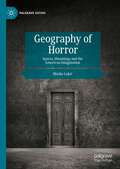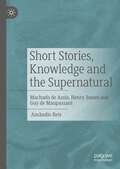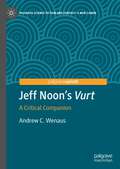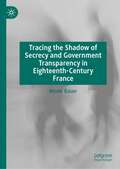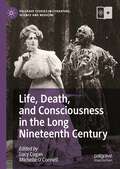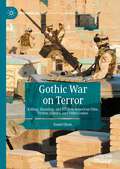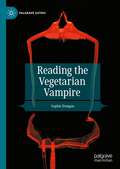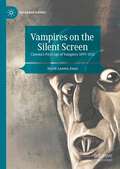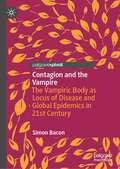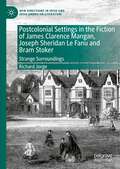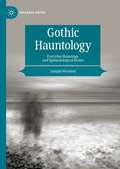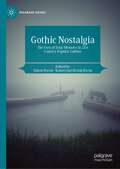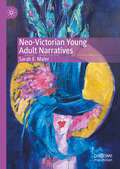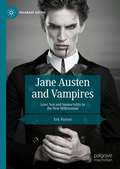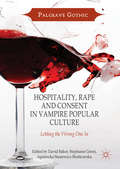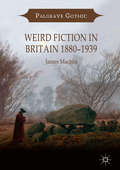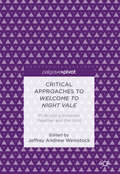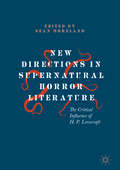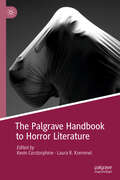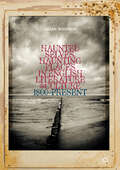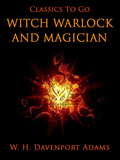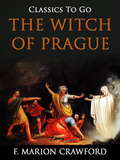- Table View
- List View
Geography of Horror: Spaces, Hauntings and the American Imagination (Palgrave Gothic)
by Marko LukićThis book provides a comprehensive reading of a space/place-based experience from the birth of the American horror genre (nineteenth century American Romanticism) to its rise and evolution in the twentieth and twenty-first centuries. Exploring a series of narratives, this study focuses on the role of space and place as key elements for successful articulation of horror. The analysis, therefore, employs different theoretical premises and concepts belonging to human geography, which, while being part of the larger discipline of geography, predominantly directs its attention towards the presence and activities of humans. By connecting such theoretical readings with the continuously evolving American horror genre, this book offers a unique insight into the academically unexplored trans-disciplinary spatially based reading of the genre.
Short Stories, Knowledge and the Supernatural: Machado de Assis, Henry James and Guy de Maupassant
by Amândio ReisThis book proposes a comparative approach to the supernatural short stories of Machado de Assis, Henry James and Guy de Maupassant. It offers an alternative to predominantly novel-centric and Anglo-centric perspectives on literary pre-modernism by investigating a transnational and multilingual connection between genre, theme and theory, i.e., between the modern short story, the supernatural and the problem of knowledge. Incorporating a close analysis of the literary texts into a discussion of their historical context, the book argues that Machado, James and Maupassant explore and reinvent the supernatural short story as a metafictional genre. This modernized and innovative form allows them to challenge the dichotomies and conventions of realist and supernatural fiction, inviting their past and present readers to question common assumptions on reality and literary representation.
Jeff Noon's "Vurt": A Critical Companion (Palgrave Science Fiction and Fantasy: A New Canon)
by Andrew C. WenausThis book offers an examination of Jeff Noon’s iconoclastic debut novel, Vurt (1993). In this first book-length study of the novel, which includes an extended interview with Noon, Wenaus considers how Vurt complicates the process of literary canonization, its constructivist relationship to genre, its violent and oneiric setting of Manchester, its use of the Orphic myth as an archetype for the practice of literary collage and musical remix, and how the structural paradoxes of chaos and fractal geometry inform the novel’s content, form, and theme. Finally, Wenaus makes the case for Vurt’s ongoing relevance in the 21st century, an era increasingly characterized by neuro-totalitarianism, psychopolitics, and digital surveillance. With Vurt, Noon begins his project of rupturing feedback loops of control by breaking narrative habits and embracing the contingent and unpredictable. An inventive, energetic, and heartbreaking novel, Vurt is also an optimistic and heartfelt call for artists to actively create open futures.
Tracing the Shadow of Secrecy and Government Transparency in Eighteenth-Century France
by Nicole BauerThis book traces changing attitudes towards secrecy in eighteenth-century France, and explores the cultural origins of ideas surrounding government transparency. The idea of keeping secrets, both on the part of individuals and on the part of governments, came to be viewed with more suspicion as the century progressed. By the eve of the French Revolution, writers voicing concerns about corruption saw secrecy as part and parcel of despotism, and this shift went hand in hand with the rise of the idea of transparency. The author argues that the emphasis placed on government transparency, especially the mania for transparency that dominated the French Revolution, resulted from the surprising connections and confluence of changing attitudes towards honour, religious movements, rising nationalism, literature, and police practices. Exploring religious ideas that associated secrecy with darkness and wickedness, and proto-nationalist discourse that equated foreignness with secrecy, this book demonstrates how cultural shifts in eighteenth-century France influenced its politics. Covering the period of intense fear during the French Revolution and the paranoia of the Reign of Terror, the book highlights the complex interplay of culture and politics and provides insights into our attitudes towards secrecy today.
Life, Death, and Consciousness in the Long Nineteenth Century (Palgrave Studies in Literature, Science and Medicine)
by Lucy Cogan Michelle O’ConnellThis book explores how the writers, poets, thinkers, historians, scientists, dilettantes and frauds of the long-nineteenth century addressed the “limit cases” regarding human existence that medicine continuously uncovered as it stretched the boundaries of knowledge. These cases cast troubling and distorted shadows on the culture, throwing into relief the values, vested interests, and power relations regarding the construction of embodied life and consciousness that underpinned the understanding of what it was to be alive in the long nineteenth century. Ranging over a period from the mid-eighteenth century through to the first decade of the twentieth century—an era that has been called the ‘Age of Science’—the essays collected here consider the cultural ripple effects of those previously unimaginable revolutions in science and medicine on humanity’s understanding of being.
Gothic War on Terror: Killing, Haunting, and PTSD in American Film, Fiction, Comics, and Video Games (Palgrave Gothic)
by Danel OlsonAfter 9/11, the world felt the “shock and awe” of the War on Terror. But that war also exploded inside novels, films, comics, and gaming. Danel Olson investigates why the paranormal, ghostly, and conspiratorial entered such media between 2002-2022, and how this Gothic presence connects to the most recent theories on PTSD. Set in New York/Gotham, Afghanistan, Iraq, and CIA black sites, the traumatic and weird works interrogated here ask how killing affects the killers. The protagonists probed are artillery, infantry, and armored-cavalry soldiers; military intelligence; the Air Force; counter-terrorism officers of the NYPD, NCIS, FBI, and CIA; and even the ultimate crime-fighting vigilante, Batman.
Reading the Vegetarian Vampire (Palgrave Gothic)
by Sophie DunganThis Pivot traces the rise of the so-called “vegetarian” vampire in popular culture and contemporary vampire fiction, while also exploring how the shift in the diet of (some) vampires, from human to animal or synthetic blood, responds to a growing ecological awareness that is rapidly reshaping our understanding of relations with others species. The book introduces the trope of the vegetarian vampire, as well as important critical contexts for its discussion: the Anthropocene, food studies, and the modern practice, politics and ideologies of vegetarianism. Drawing on references to recent historical contexts and developments in the genre more broadly, the book investigates the vegetarian vampire’s relationship to other more violent and monstrous forms of the vampire in popular twenty-first century horror cinema and television. Texts discussed include Interview with the Vampire, Buffy the Vampire Slayer, Twilight, The Vampire Diaries and True Blood. Reading the Vegetarian Vampire examines a new aspect of contemporary interest in considering vampire fiction.
Vampires on the Silent Screen: Cinema’s First Age of Vampires 1897-1922 (Palgrave Gothic)
by David Annwn JonesThis book is the first study of the vampires in silent cinema, presenting a detailed academic yet accessible discussion of the films themselves and their sources. For the very first time, The Fire Elemental from the Wharton brothers’ The Mysteries of Myra (1916) is identified as cinema’s original vampire, his appearance initiating a rich and variegated period of film production that is currently missing from studies of horror cinema. Exciting and ground-breaking, Vampires on the Silent Screen also discusses Drakula Halála / Dracula’s death (1920), the first ever filmic female vampire in Erich Kober’s Lilith and Ly (1919), and the Dracula lookalike, Count Merlin in Alexander Korda’s Magic (1917) as well as many other productions. A socio-cultural framework with critical highlighting of eco-horror theory is used throughout to draw these unique discoveries together. This project is a must read for any horror enthusiasts out there.
Contagion and the Vampire: The Vampiric Body as Locus of Disease and Global Epidemics in 21st Century
by Simon BaconThis book examines how the vampire has always been connected to ideas of infection, pollution and disease—even more so in the 21st century where it expresses the horrors of unseen and unstoppable disease and the foreboding and anxiety that accompany viral outbreaks and wider epidemics. Here the vampire gives physical form to the contagion and associated anxieties around the perceived causes and spread of disease, where it can take on many forms from animal to pestilential particulate matter, creeping shadows and even malignant weather systems. If blood is life, it is the body of the vampire that is death. This timely study looks at how and why the vampire continues to fulfil this function and posits that the true patient zero in the 21st century is no longer the dangerous, ancient, outsider from the East but is the undying monster that is Western culture itself.
Postcolonial Settings in the Fiction of James Clarence Mangan, Joseph Sheridan Le Fanu and Bram Stoker: Strange Surroundings (New Directions in Irish and Irish American Literature)
by Richard JorgeThis book explores how three Anglo-Irish writers, J.C. Mangan, J.S. Le Fanu and Bram Stoker, use settings in their short fictions to recreate, depict and confront Ireland’s colonial situation in the nineteenth century. This study provides an innovative approach by targeting a genre (the short story) which has not been explored in its entirety— certainly not within nineteenth century Ireland - much less using a postcolonial approach to the short story. Added to this is the fact that it analyses how these writers used settings as an anticolonial tool. To do so, the book is divided into two major sections, an analysis of Irish settings and non-Irish ones. It works on the premise that all three writers used the idea of displacement to target colonialism and its effects on Irish society. In short, this book addresses a gap in scholarship, as the Irish Gothic short story as a decolonizing tool has not been sufficiently and globally studied.
Gothic Hauntology: Everyday Hauntings and Epistemological Desire (Palgrave Gothic)
by Joakim WrethedThis book provides a theoretically informed account of Gothic Hauntology. It is distinctive foremost in two ways. It shows hauntology at work in modern as well as older gothic narratives and it has a unique focus on everyday gothic as well as everyday hauntology. The chapters perform a historical circle going from Munro to Poe and then back again, offering novel readings of works by well-known authors that are contextualized under the umbrella of the theme. Anchored in a well-known topic and genre, but with a specific phenomenological framework, this book will be of interest to both students and more advanced scholars.
Gothic Nostalgia: The Uses of Toxic Memory in 21st Century Popular Culture (Palgrave Gothic)
by Simon Bacon Katarzyna Bronk-BaconThis book is an original and innovative study of how Gothic nostalgia and toxic memory are used to underpin and promote the ongoing culture wars and populist politics in contemporary popular culture. The essays collected here cover topics from the spectral to the ecological, deep fakes to toxic ableism, Mary Poppins to John Wick to reveal how the use of an imaginary past to shape the present, creates truly Gothic times that we can never escape. These ‘hungry ghosts’ from the past find resonance with the Gothic which speaks equally of a past that often not only haunts the present but will not let it escape its grasp. This collection will look at the confluence between various kinds of toxic nostalgia and popular culture to suggest the ways in which contemporary populism has resurrected ideological monsters from the grave to gorge on the present and any possibility of change that the future might represent.
Neo-Victorian Young Adult Narratives
by Sarah E. MaierNeo-Victorian Young Adult Narratives examines the neo-Victorian themes and motifs currently appearing in young adult fiction—specifically addressing the themes of authorship, sexuality, and criminality in the context of the Victorian age in British and American cultures. This book explicates the complicated relationship between the Victorian past and the turn to Victorian modes of thought on literature, history, and morality. Additionally, Sarah E. Maier aims to determine if the appeal of neo-Victorian young adult fiction rests in or resists nostalgia, parody, and revision. Given the overwhelming prevalence of the Victorian in the young adult genres of biofiction, juvenile writings, gothic, sensation, mystery, and crime fiction, there is much to investigate in terms of the friction between the past and the present.
Jane Austen and Vampires: Love, Sex and Immortality in the New Millennium (Palgrave Gothic)
by Eric ParisotJane Austen and Vampires is the first book to investigate the literary convergence of Jane Austen and vampires in Austen fanfic after the success of Stephenie Meyer’s Twilight (2005) and Seth Grahame-Smith’s Pride and Prejudice and Zombies (2009). It asks how the shifting cultural values of Austen and the vampire have aligned, and what their connection might mean for their respective contemporary legacies. It also makes a case for reading “low brow” Austen fanfic attentively, as a way to gain meaningful insight directly from Austen fans into the tensions and anxieties surrounding contemporary notions of love, sex, femininity, and Austen’s modern currency. Offering close readings of Austen’s vampire-slaying heroines, vampiric retellings of Pride and Prejudice, and the transformation of Austen herself into a vampire, this book reveals Austen-vampire mashups as messy, complex entanglements that creatively and self-reflexively interrogate modern fantasies of vampire romance. By its unique intersection of Jane Austen with the vampire, the Gothic, fan culture and popular romance, Jane Austen and Vampires adds a new chapter to the history of Austen’s reception, for fans, students and scholars alike.
Hospitality, Rape and Consent in Vampire Popular Culture
by David Baker Stephanie Green Agnieszka Stasiewicz-BieńkowskaThis unique study explores the vampire as host and guest, captor and hostage: a perfect lover and force of seductive predation. From Dracula and Carmilla, to True Blood and The Originals, the figure of the vampire embodies taboos and desires about hospitality, rape and consent. The first section welcomes the reader into ominous spaces of home, examining the vampire through concepts of hospitality and power, the metaphor of threshold, and the blurred boundaries between visitation, invasion and confinement. Section two reflects upon the historical development of vampire narratives and the monster as oppressed, alienated Other. Section three discusses cultural anxieties of youth, (im)maturity, childhood agency, abuse and the age of consent. The final section addresses vampire as intimate partner, mapping boundaries between invitation, passion and coercion. With its fresh insight into vampire genre, this book will appeal to academics, students and general public alike.
Weird Fiction in Britain 1880–1939 (Palgrave Gothic)
by James MachinThis book is the first study of how ‘weird fiction’ emerged from Victorian supernatural literature, abandoning the more conventional Gothic horrors of the past for the contemporary weird tale. It investigates the careers and fiction of a range of the British writers who inspired H. P. Lovecraft, such as Arthur Machen, M. P. Shiel, and John Buchan, to shed light on the tensions between ‘literary’ and ‘genre’ fiction that continue to this day. Weird Fiction in Britain 1880–1939 focuses on the key literary and cultural contexts of weird fiction of the period, including Decadence, paganism, and the occult, and discusses how these later impacted on the seminal American pulp magazine Weird Tales. This ground-breaking book will appeal to scholars of weird, horror and Gothic fiction, genre studies, Decadence, popular fiction, the occult, and Fin-de-Siècle cultural history.
Weird Fiction in Britain 1880–1939 (Palgrave Gothic)
by James MachinThis book is the first study of how ‘weird fiction’ emerged from Victorian supernatural literature, abandoning the more conventional Gothic horrors of the past for the contemporary weird tale. It investigates the careers and fiction of a range of the British writers who inspired H. P. Lovecraft, such as Arthur Machen, M. P. Shiel, and John Buchan, to shed light on the tensions between ‘literary’ and ‘genre’ fiction that continue to this day. Weird Fiction in Britain 1880–1939 focuses on the key literary and cultural contexts of weird fiction of the period, including Decadence, paganism, and the occult, and discusses how these later impacted on the seminal American pulp magazine Weird Tales. This ground-breaking book will appeal to scholars of weird, horror and Gothic fiction, genre studies, Decadence, popular fiction, the occult, and Fin-de-Siècle cultural history.
Critical Approaches to Welcome to Night Vale: Podcasting between Weather and the Void
by Jeffrey Andrew WeinstockWith well over one-hundred episodes, the podcast Welcome to Night Vale has spawned several international live tours, two novels set in the Night Vale universe, and an extensive volume of fan fiction and commentary. However, despite its immense popularity, Welcome to Night Vale has received almost no academic scrutiny. This edited collection of scholarly essays—the very first of its kind on a podcast—attempts to redress this lack of attention to Night Vale by bringing together an international group of scholars from different disciplines to consider the program’s form, themes, politics, and fanbase. After a thorough introduction by the volume’s editor, Jeffrey Andrew Weinstock, the eight contributors not only offer close analysis of Night Vale, but use the program as the impetus for broader explorations of new media, gender, the constitution of identity, the construction of place, and the human relationship to meaning and the non-human.
Critical Approaches to Welcome to Night Vale: Podcasting between Weather and the Void
by Jeffrey Andrew WeinstockWith well over one-hundred episodes, the podcast Welcome to Night Vale has spawned several international live tours, two novels set in the Night Vale universe, and an extensive volume of fan fiction and commentary. However, despite its immense popularity, Welcome to Night Vale has received almost no academic scrutiny. This edited collection of scholarly essays—the very first of its kind on a podcast—attempts to redress this lack of attention to Night Vale by bringing together an international group of scholars from different disciplines to consider the program’s form, themes, politics, and fanbase. After a thorough introduction by the volume’s editor, Jeffrey Andrew Weinstock, the eight contributors not only offer close analysis of Night Vale, but use the program as the impetus for broader explorations of new media, gender, the constitution of identity, the construction of place, and the human relationship to meaning and the non-human.
New Directions in Supernatural Horror Literature: The Critical Influence of H. P. Lovecraft
by Sean MorelandThis collection of essays examines the legacy of H.P. Lovecraft’s most important critical work, Supernatural Horror in Literature. Each chapter illuminates a crucial aspect of Lovecraft’s criticism, from its aesthetic, philosophical and literary sources, to its psychobiological underpinnings, to its pervasive influence on the conception and course of horror and weird literature through the twentieth and early twenty-first centuries. These essays investigate the meaning of cosmic horror before and after Lovecraft, explore his critical relevance to contemporary social science, feminist and queer readings of his work, and ultimately reveal Lovecraft’s importance for contemporary speculative philosophy, film and literature.
New Directions in Supernatural Horror Literature: The Critical Influence of H. P. Lovecraft
by Sean MorelandThis collection of essays examines the legacy of H.P. Lovecraft’s most important critical work, Supernatural Horror in Literature. Each chapter illuminates a crucial aspect of Lovecraft’s criticism, from its aesthetic, philosophical and literary sources, to its psychobiological underpinnings, to its pervasive influence on the conception and course of horror and weird literature through the twentieth and early twenty-first centuries. These essays investigate the meaning of cosmic horror before and after Lovecraft, explore his critical relevance to contemporary social science, feminist and queer readings of his work, and ultimately reveal Lovecraft’s importance for contemporary speculative philosophy, film and literature.
The Palgrave Handbook to Horror Literature
by Kevin Corstorphine Laura R. KremmelThis handbook examines the use of horror in storytelling, from oral traditions through folklore and fairy tales to contemporary horror fiction. Divided into sections that explore the origins and evolution of horror fiction, the recurrent themes that can be seen in horror, and ways of understanding horror through literary and cultural theory, the text analyses why horror is so compelling, and how we should interpret its presence in literature. Chapters explore historical horror aspects including ancient mythology, medieval writing, drama, chapbooks, the Gothic novel, and literary Modernism and trace themes such as vampires, children and animals in horror, deep dark forests, labyrinths, disability, and imperialism. Considering horror via postmodern theory, evolutionary psychology, postcolonial theory, and New Materialism, this handbook investigates issues of gender and sexuality, race, censorship and morality, environmental studies, and literary versus popular fiction.
Haunted Selves, Haunting Places in English Literature and Culture: 1800–Present
by Julian WolfreysHaunted Selves, Haunting Places in English Literature and Culture offers a series of readings of poetry, the novel and other forms of art and cultural expression, to explore the relationship between subject and landscape, self and place. Utilizing an interdisciplinary approach grounded in close reading, the text places Jacques Derrida’s work on spectrality in dialogue with particular aspects of phenomenology. The volume explores writing and culture from the 1880s to the present day, proceeding through four sections examining related questions of identity, memory, the landscape, and our modern relationship to the past. Julian Wolfreys presents a theoretically informed understanding of the efficacy of literature and culture in connecting us to the past in an affective and engaged manner.
Witch, Warlock, and Magician: Historical Sketches Of Magic And Witchcraft In England And Scotland (Classics To Go)
by W. H. Davenport AdamsIt was not the author's purpose in this volume to attempt a general history of magic and alchemy, or a scientific inquiry into their psychological aspects. He confined himself to a sketch of their progress in England and to a narrative of the lives of our principal magicians. It is also devoted to a historical review of witchcraft in Great Britain, and an examination into the most remarkable witch trials. (Excerpt from Goodreads)
The Witch of Prague: A Fantastic Tale (Classics To Go)
by F. Marion CrawfordExcerpt: "A great multitude of people filled the church, crowded together in the old black pews, standing closely thronged in the nave and aisles, pressing shoulder to shoulder even in the two chapels on the right and left of the apse, a vast gathering of pale men and women whose eyes were sad and in whose faces was written the history of their nation. The mighty shafts and pilasters of the Gothic edifice rose like the stems of giant trees in a primeval forest from a dusky undergrowth, spreading out and uniting their stony branches far above in the upper gloom. From the clerestory windows of the nave an uncertain light descended halfway to the depths and seemed to float upon the darkness below as oil upon the water of a well. Over the western entrance the huge fantastic organ bristled with blackened pipes and dusty gilded ornaments of colossal size, like some enormous kingly crown long forgotten in the lumber room of the universe, tarnished and overlaid with the dust of ages. Eastwards, before the rail which separated the high altar from the people, wax torches, so thick that a man might not span one of them with both his hands, were set up at irregular intervals, some taller, some shorter, burning with steady, golden flames, each one surrounded with heavy funeral wreaths, and each having a tablet below it, whereon were set forth in the Bohemian idiom, the names, titles, and qualities of him or her in whose memory it was lighted. Innumerable lamps and tapers before the side altars and under the strange canopied shrines at the bases of the pillars, struggled ineffectually with the gloom, shedding but a few sickly yellow rays upon the pallid faces of the persons nearest to their light."
